
25 minute read
Whom should we thank for our family?
Maximize Your Sunday School Class by Stacy Wallace and Noel Hall
Do you want to make the most of your Sunday School class each week? These four concepts will help any teacher improve his or her teaching. Make the Most of Your Room
Each Sunday School room has its own pluses and minuses. But with creativity and thought you can make the best of any classroom.
First, is your room clean and kid-friendly? Check your room and adjust as needed to make it clean and well-lit. Make sure the chairs and tables and wall art are at the child’s height.
Second, ask yourself, “If my table fills the room, would floor pillows and lap desks be better for the children?”
Third, consider how your room affects your lessons. Can you set up all activities before class? Or will you need to set up activities as you go? How can you modify activities for a small room? Manage Interpersonal Dynamics
Interpersonal dynamics affect each class session. A class with three quiet children has a different dynamic than a class with eight highenergy children. The personalities and moods of adults in the room also impact the class dynamics.
First, set a consistent class schedule. Routine helps children feel secure, no matter how much the class dynamics vary from week to week.
Second, for each lesson, prepare options for both quiet and high-energy classes. Page 6 of this teacher guide offers other lesson helps.
Third, plan ahead for discipline challenges. Be prepared for hyperactive children, arguments, and shy children. Dealing with all of these challenges is a normal and natural part of Sunday School teaching.
Maximize Your Teaching Style
Are you a strong disciplinarian who wants every child doing the same thing quietly? Or do you think noise and movement is the normal state of a children’s classroom? Knowing your teaching style will cause you to be aware of your strengths and weaknesses.
If you are a strong disciplinarian, you may need to let students have more freedom and more choices. You may need to ignore some wiggles and squirms and chattering.
If you are really relaxed, set boundaries and limits. Create three to five simple rules such as “Raise your hand before you talk,” “Use only kind words,” and “Keep your hands and feet to yourself.” Then help each child obey those rules.
Be Prepared
Preparation will make any class less hectic. If your lesson plan is ready, your supplies are set up, and you are waiting when the first child arrives, your class is off to a good start.
First, make sure your class has all the basic supplies: crayons, markers, scissors, glue, etc.
Second, locate additional supplies. Each lesson in this book has a list of supplies on page 1 of the lesson.
If you need help with supplies, make a list a couple of weeks in advance. Give the list to parents or other church members so they can help.
Third, make sure your lesson plan is available to all your teaching team. Page 7 of this book provides a single-page lesson plan.
Finally, the most important thing you can do is to study the Bible story for the week and pray for the children, yourself, and your teachers/helpers. God hears and answers prayer.
Teaching Strategies for Kindergarten Teachers
Strategies for helping children PHYSICALLY
• Alternate times of quiet and activity. • Snacks can be quite helpful. • Give students opportunities to jump, skip, and stretch. • Don’t expect children to sit still.Wiggling is natural. • Offer cutting, puzzles, and tracing to use small muscles. • Some may have difficulty cutting and coloring within the lines. Help these children enjoy their own progress.
Strategies for helping children MENTALLY
• Use activities that let the children enjoy both the process and the end result. • Talk about strategies and the concepts of why and how. • Use role play, “what if” games, and drama. • Help children place themselves in others’ roles, and thus learn to understand and solve the problems of others. • Let children both ask questions and discover the answers. • When you answer a question, speak concretely. • Offer new and varied learning experiences. • Explain things in the simplest, most concrete way possible. • A void church phrases such as “under conviction.” • Make time for the children to talk. • Ask questions that require more than yes or no answers. • Provide varied activities in which the child can see, feel, smell, hear, and taste. • Plan activities to fill about 10 minutes each. • Do not leave unplanned time. Your students’ creative minds will find a way to fill the time.
Strategies for helping children EMOTIONALLY
• Express your approval with words, pats on the back, smiles, and eye contact. • Distinguish between a child’s bad behavior that you disapprove and the child whom you love. • Teach how to appropriately express emotions. • Help an upset child realize it’s okay to feel angry, but it’s not okay to yell, hit, or kick. • Help an excited child express excitement without yelling. • Keep things in familiar places. • Use the same basic lesson structure each week. • Make changes in steps. • Make a few simple rules, review them frequently, and enforce them consistently. • Use a time-out as a consequence for disobedience. • Make sureachild knows that she chose time-out because she chose to disobey. • Keep time out focused on helpingachild change his behavior, not on punishing him. • Let your class choose often. Freedom to choose prevents frustration and helps develop the child’s sense of self-worth.
Strategies for helping children SOCIALLY
• During this year, children move from parallel play (playing by another child) to actually playing with a nother child. • Help children to successfully play with others. • Help children identify how their actions affect others. • When you see friendly behaviors such as helping or kindness, compliment those actions. • Help children learn to negotiate their conflicts. • Help children learn to take turns. Manage the amount of time a child has to wait to take a turn. Less time waiting equals a better chance of success. • Help children learn to share. Monitor the amount of sharing so children don’t get too frustrated. • self-expression. Realize the children have a desire for attention and • Provide personal attention and give frequent opportuni ties for children to express themselves. • Avoid personal competition. • Use games in which participation, not winning, is the goal.
Kindergarten Teacher Guide
9 Strategies for helping children SPIRITUALLY
• Help children develop love and trust for God. • Help each child look forward to church. Positive emotions about God, the Bible, and church help a child become open to salvation. • Help children believe the Bible is like no other book. It is God’s special book to teach about God and His plans. • Teach that the Bible is always true. • Teach Bible stories, memory verses, and spiritual truths. • Teach children about God, Jesus, and the Holy Spirit. Help them learn that all three are equally God. • Children can learn that Jesus is God as well as a man. • Teach them that God knows and loves them personally. He wants relationship with them.
Unit 1 Overview
Joseph and Joshua Love God
Joseph and Joshua both demonstrate godly character. Because of Joseph’s character, he survived betrayal, slavery, false accusation, and jail to become the second ruler of Egypt.
Joshua demonstrated his godly character by serving as Moses’ obedient servant for many years. (See Exodus 24:13 and 33:11.) He, too, became a mighty leader.
Both Joseph and Joshua survived the molding process to become great leaders. Teach children that being the right person and doing the right thing—even when it is tough—is important. Help your students develop godly character.
Unit 1 Objectives By studying these five lessons, the child will • explore Bible stories from the lives of Joseph Joshua, and Rahab, • recognize that God helped people through Joseph, Joshua, and Rahab, • and rejoice because God helps His people.
Room Decorations
Alphabet Line: An alphabet line is provided in the Kindergarten Resource Packet. For this unit, refer to the letter “J” for Joseph and Joshua.
Unit and Virtue Posters: Four mini-posters are provided in the resource packet. Display the Unit 1 Posters and the Virtue Poster.

J Room: Feature the letter “J” in your room throughout the unit. Cut out, post, and hang variations of this letter wherever space allows.
Squirrel Coloring Sheet: Use this coloring sheet found in the back of the Kindergarten Lesson Pages to fill time at the end of a short lesson. Then reward your students’ efforts by posting their artwork on your seasonal bulletin board. Be sure to write each child’s name on his sheet so you can send his work home with him when you update your bulletin board for the winter quarter.
Unit Memory Verse
All things work together for good to them that love God. Romans 8:28 (KJV)
In all things God works for the good of those who love him. Romans 8:28 (NIV)
Verse Puzzle: Draw and cut out a large “J” from poster board. Print each word of the verse in such a way that the words can be separated into jigsaw puzzle pieces. Cut the pieces so each edge has a clear partner. Use the pieces on the floor or table or board and let the children assemble them every week. Read the words to them. Encourage them to say the words as they put the pieces in place.
Phrase Memorization: Decide how the verse naturally breaks into two or three phrases. Tell children they are to echo your words. In following weeks, use longer phrases.
Unit Action Rhyme
“J” is for Joseph with a coat so rich and swell, (Draw “J” in the air; smooth clothes.) His brothers got upset and left him in a well. (Put hands on hips; shove down and out.) Yet Joseph grew into a man of power so great. (Move hand from knee to high; salute.) He sold grain to feed many before it was too late. (Hold out both hands; pretend to eat.) “J” is for Joshua too, who rescued Rahab’s kin. (Draw “J” in air; reach hand out as if to help someone up.) The Jordan River dried up as he led his people in. (Make water flowing motions; walk hands.) Jericho fell as Joshua’s men their trumpets blew. (Wave hands for falling walls; cup hands as if blowing a trumpet.) Both “J” men loved the Lord their God. Do you? (Make “J” with both hands; point out with both hands.)
Song Suggestions
Resource Packet Songs: These songs are provided on the CD in the Kindergarten Resource Packet. These songs will complement Unit 1.
“Jesus, I Love You” “Love and Follow” “All Things Work Together for Good”
“Zacchaeus”: You will find in the resource packet a colorful songbook poster, printed music, and a CD recording. Instructions for folding the poster into a book are provided on the inside cover of the resource packet. Tracks 6 and 12 of the packet CD are recordings of the song. Sheet 6 has the printed music for this song.
NOTE: With just one slit and the instructions provided in the resource packet, you can fold the “Zacchaeus” Song Visual into an 8-page booklet.
Additional Songs: Sing other songs of your choosing that also reinforce the Unit 1 lessons.
Worship Ideas
Letter Thanks: Point to a letter on the alphabet line and name something that begins with that letter for which you are thankful. For example, for “J,” you might express thanks for “Jam” or “Jane.” Let each child in turn point to a letter and name something he is thankful for.
Ribbon Worship: Bring a long, red ribbon to the worship circle. Every child should hold part of it. Let them take turns naming their own family members. Then pray for God to bless them all.
Trumpet Praise: Let the children imitate Joshua’s men as they marched around Jericho blowing their trumpets to honor God. Let children blow paper trumpets to celebrate God’s power.
Offering Ideas
“J” Container: Use a “J”ar or a “J”ug to collect love gifts for “J”esus during this unit. Each week hold up the offering container during worship time and pray over the offering. Help students learn that giving is an act of worship as much as singing and prayer.
Giving Discussion: Talk with the class about why we give offerings (because we love God) and how it helps to show others God’s love. Tell how the church uses the offerings.
Often children have no idea that others, young and old, are in Sunday School at the same time they are. Describe all the people who are in Sunday School and say they are also giving. People who give to God are His helpers.
Giving Medals: Using plastic lids, ribbon, yarn, and paper, create necklaces that say “I gave.” After the children give, let each one wear a giving medal.
Teaching Tip: Bring coins to share so every child can give an offering and wear a medal.
Attendance
Each quarter, the resource packet contains Attendance Posters, a Chart Poster, and Chart Stickers that can be used for attendance or incentives.
Kindergarten Handwork Packet also provides an attendance page and matching stickers.
Joseph’s Special Coat
Lesson 1 • September 6, 2020
UNIT 1: Joseph and Joshua Love God
Teacher Focus
Joseph was the apple of his father’s eye. He had what every child wants and needs—the knowledge that he is special. As you teach this lesson, focus on Jacob’s reason for giving the coat. He wanted Joseph to know how special and loved he was. Help your students realize that they too are special in their families. Help motivate them to care for their own special family members.
Remember, each child you teach is special to God and to his family. Help him celebrate that fact in Sunday School this week.
Memory Verse The father of [a] righteous [child] shall greatly rejoice. Proverbs 23:24 (KJV) The father of a good child is very happy. Proverbs 23:24 (NCV)
Bible Text Genesis 37:1–4,12–19,23,24,28,32
Objective The child will be able to tell why Joseph’s coat was special.
Life Application Family: To help each child believe he is special to his family.
We Believe God created families as the basis of society.
LESSON STEP ACTIVITY MATERIALS NEEDED
Coming to God’s House
5–10 minutes
Attendance ....................................... Page 94, items from the Kindergarten Resource Packet Unit Ideas ......................................... See pages 10 and 11. Welcome ........................................... Colorful robe or large shirt Lesson Lead-In Family Pictures ......................... Drawing paper, markers or crayons Coat Game ................................. Colorful robe or large shirt, open space for a game
Learning Bible Story....................................... Visual 1 of the Kindergarten Bible Visuals, flannel board, God’s Word Bible 5–10 minutes
Applying God’s Word
15–20 minutes
Color the Coat Review................... Marker board, markers, review question on page 15 Student Book.................................... Kindergarten Lesson Pages, crayons or markers, pencils Memory Verse ................................ Sign language shown on page 15
Taking God’s Word Home
10–15 minutes
Kindergarten Handwork Packet ... Activity 1, stickers, crayons or markers Kindergarten Resource Packet Coat Puzzles .............................. Precut Sheet 7 coats, construction paper, glue or tape, scissors Painted Coats ........................... Cardboard copies of Sheet 7 coat, finger paints, plastic wrap, newspapers, paper towels, water Letter to Parents ...................... Copies of sheets 1 or 2, one per child Take-Home Paper ........................... Kidz Adventures
Extended Snack ............................................... Jelly beans or colorful cereal loops, drinks, napkins Session Ideas Coat Collage .................................... Poster board robe, glue, fabric scraps
Church Time Sharing Circle .................................. Colorful shirt Coat Relay........................................ Two colorful robes or large shirts Closing Game .................................. Colorful shirt Cleanup Idea ................................... Colorful robe or shirt
Coming to God’s House (5–10 min.)
Attendance, Songs, Worship, Giving: See pages 10 and 11 for unit ideas. A unit action rhyme is also provided on page 11.
Welcome: Greet each child warmly. Let her know you’re glad to see her. Place a colorful robe or large shirt by the door. Let each child try it on. Say, “Today, we will learn about a special robe.” Then guide each child to an activity.
LESSON LEAD-IN
Family Pictures: Provide drawing paper and markers. Let each child draw a picture of his family. As the children work, ask about their families. You might ask, “Is this your big sister? What is her name? How many people are in your family?”
Then ask questions of the group and let children stand up to answer: “Who has a big brother? a little sister? Who is the oldest in their family? the youngest in their family?” Also include questions about blended families such as, “Who has a
stepmother? Who has a stepbrother?”
Coat Game: Have the children stand in a circle. Place a colorful shirt or robe on a child. He is “Joseph.” Whisper to him whom to tap. (This assures that every child is tapped.) He then walks behind the circle and taps that child. He and the tapped child race around the circle in opposite directions. No matter who arrives first, the two children trade places.
OPTION
Learning God’s Word (5–10 min.)
BIBLE STORY This lesson is from Genesis 37:1–4,12–19,23,24,28,32. Use the Bible story and visuals to teach students about Joseph’s special coat and how Joseph was special to his family.
JACOB LOVES JOSEPH
(Display Figures 1A and 1B from Visual 1 of the Kindergarten Bible Visuals.) Jacob loved his son Joseph very much. Jacob wanted Joseph to know he was special. So Jacob gave Joseph a very special gift.
Do you think Joseph was excited to get a gift from his father? Do you like to get gifts from your father and mother? Raise your hand if you like to get gifts from your parents.
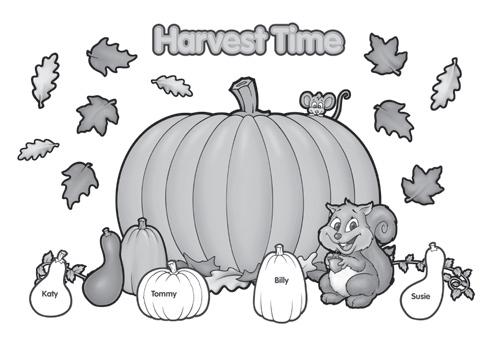
An attendance wall display is provided in the Kindergarten Resource Packet. See page 94 and the inside back cover for more information.
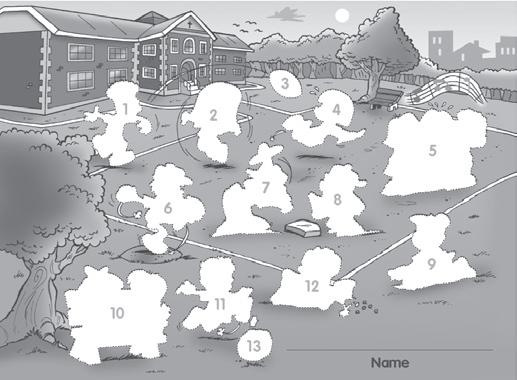
An attendance sticker picture is provided in Kindergarten Handwork Packet.
Handwork Packet Sticker Picture
Teacher Tip
Open your Bible to Genesis 37. Put the visuals where you can add them to the display.
Figures 1A & 1B
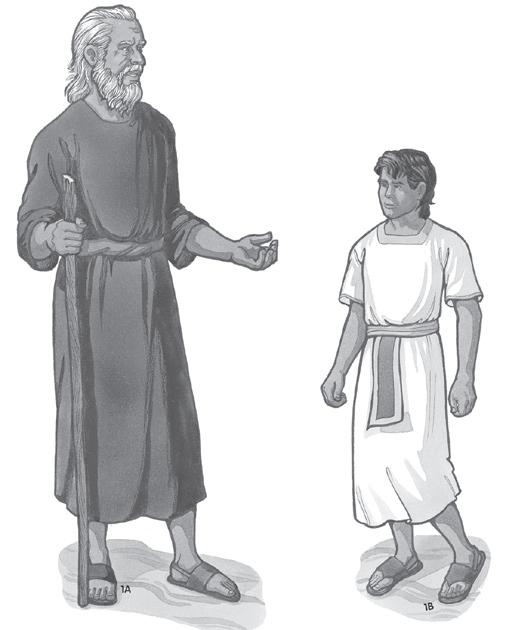
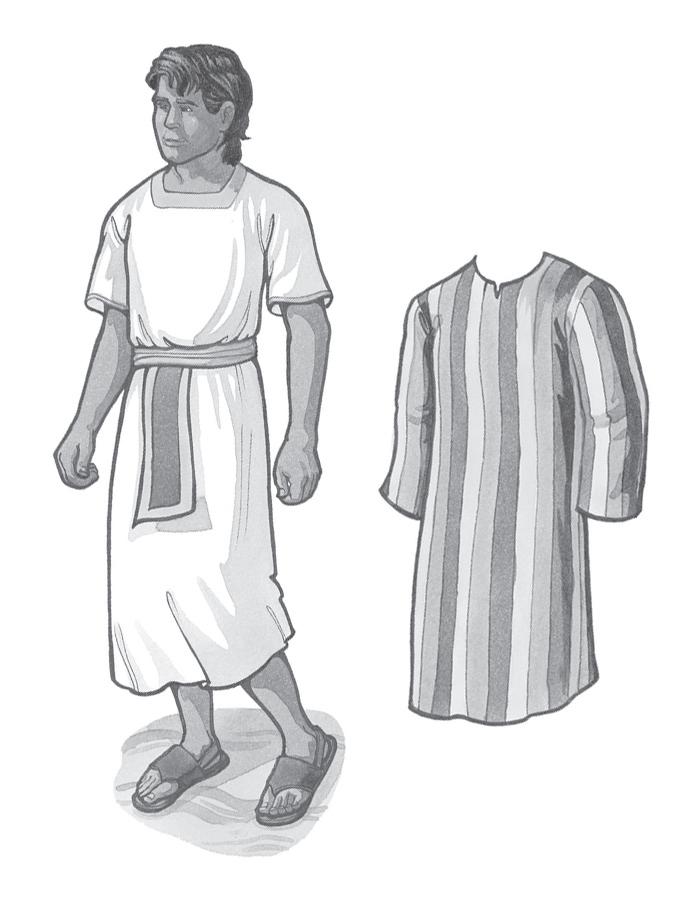
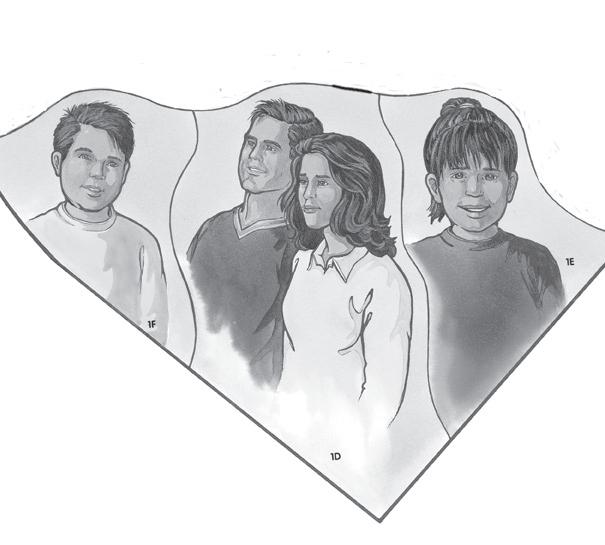
Figures 1D, 1E & 1F
Figures 1D thru 1H

JOSEPH’S SPECIAL COAT
Let’s pretend we are opening a gift. (Lead the class in pretending to unwrap a gift.) We don’t know how the special coat was wrapped. Maybe it was not wrapped at all. But it was very special. It was a wonderful coat of many colors. (Add Figure 1C, coat, over Joseph’s plain clothing.)
The coat was a very special gift for Joseph. He must have felt happy when he put on the coat. He must have felt proud too. His father had given him a special gift.
A SPECIAL PART OF THE FAMILY
Jacob wanted his son Joseph to know that he was a special part of the family. Did you know that you are as special as Joseph? Each of you is special to God.
DIFFERENT PARTS
God planned for different people to be a part of each family. (Display 1D, first puzzle piece.) God made mothers and fathers to be a part of each family. Mothers and fathers are a special part of God’s plan for families. Are you glad God gave you a mother and a father? Yes, I’m glad too. (Be sensitive to children with bad parents, no parents, or divorced parents.)
GOD GIVES DAUGHTERS
(Add 1E, second puzzle piece.) God made daughters. They are a special part of God’s plan for families. Who is special in her family because she is a daughter? Raise your hand if you are a special daughter. (Count raised hands.) We have (number) special daughter(s) in our class.
GOD GIVES SONS
(Add 1F, third puzzle piece.) God made sons. They are a special part of God’s plan for families. Who is special in his family because he is a son? Raise your hand if you are a special son. (Count raised hands.) We have (number) special son(s) in our class.
GOD GIVES GRANDPARENTS
(Add 1G, fourth puzzle piece.) God made grandfathers and grandmothers. They are special parts of God’s plan for families. Are you glad for your grandmother and grandfather?
GOD GIVES EXTENDED FAMILIES TOO
(Add 1H, last puzzle piece.) God made aunts and uncles and many other family members too. They are all special parts of God’s plan for families. God made many different people part of His special plan for families.
PRAYER TIME
You are a special part of your family. Can we thank God for you? Yes, we can. Can we thank God for your family too? Yes, we can. Let’s do that right now. (Lead the class in prayer.)
Applying God’s Word (15–20 min.)
Use one or more of the following activities to review the lesson and to help the children believe they are special to their families.
BIBLE REVIEW
Color the Coat: You will need a marker board, markers, and review questions. Draw a robe with 10 stripes on the board.
Ask each child in turn a review question. After she answers correctly, let her color a stripe on the coat.
Questions: These questions will help you review today’s lesson. 1. Who was the father who loved his son? (Jacob) 2. What gift did the father give to the son? (a colorful coat) 3. What was the name of the son? (Joseph) 4. Who made fathers to be special in their families? (God) 5. Who made mothers to be special in their families? (God) 6. Are sons special? (yes) 7. Are daughters special? (yes) 8. Who made grandparents, aunts, and uncles special? (God) 9. Why are all families special? (because God made them special) 10. Whom should we thank for our family? (God)
LESSON PAGES
You will need for each child a copy of Lesson 1 from Kindergarten Lesson Pages. You will also need crayons and pencils.
Give each child a copy of the lesson page. Help him work the first page. Then tell him to turn over his paper and color the Bible story picture of Joseph’s coat.
Ask, “What did Joseph’s father give him? Joseph was
special to his father. You are special to your family too.”
MEMORY VERSE The father of [a] righteous [child] shall greatly rejoice. Proverbs 23:24 (KJV) The father of a good child is very happy. Proverbs 23:24 (NCV)
Teach the signs below. Say the verse in unison several times with the signs. Then let each child in turn stand by you to “lead” the class in saying and signing the verse.
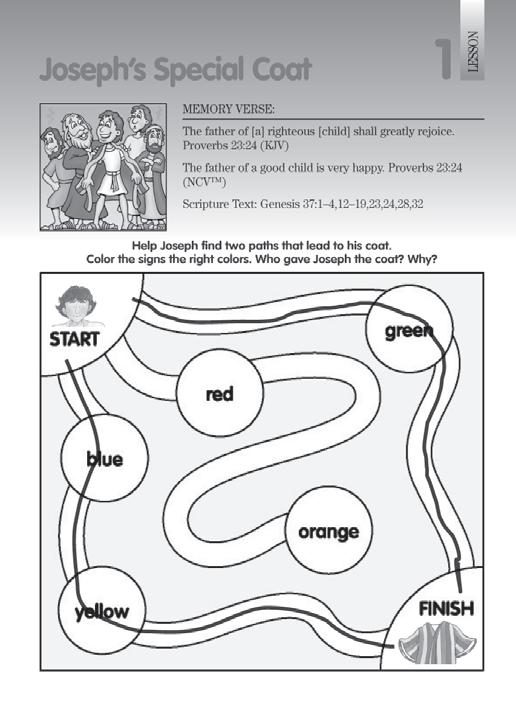

If you prefer to teach one unit verse for Lessons 1–5, see page 10.
Coat Puzzles, Sheet 7
Painted Coats, Sheet 7
EVALUATION
1. Was each child able to tell why Joseph’s coat was special? 2. Did I help each child believe he is special to his family?
Taking God’s Word Home (10–15 min.)
HANDWORK
You will need for each child a copy of Activity 1 and the matching sticker from Kindergarten Handwork Packet. Also provide crayons or markers.
Give each child an activity page. Let her place the sticker and color the robe. Then help her punch out the pieces. Show her how to choose three strips and weave them into Joseph’s coat.
Say, “Joseph felt loved when his father made a coat for him.
Can you do something for someone to make them feel loved?”
RESOURCE PACKET
Coat Puzzles: You will need construction paper, glue or tape, scissors, and for each child a copy of Sheet 7 from the Kindergarten Resource Packet. Before class, photocopy the coat onto many colors of paper. Cut out each coat.
Give each child a precut coat. He will cut the coat on the dotted lines to make puzzle pieces. Then let the class trade coat pieces so each child has at least one piece of every color. He will glue the pieces to a full sheet of paper to make a colorful coat. Under or above the coat, help him print “I am special.”
Say, “Joseph had a colorful coat to show that he was special.
You are special in your family too. To whom in your family can you give your picture? You will make them feel special.” OPTION
Painted Coats: You will need cardboard copies of the coat on Sheet 7 from the Kindergarten Resource Packet, finger paints, plastic wrap, newspapers, paper towels, and water.
Before class, place two or three spoonfuls of paint on each cardboard coat. Cover the shape with plastic wrap, sealing the edges. Cover the table with newspapers for protection.
Give each child a plastic-wrapped shape. Let the children squish the paint around, moving the paint until they are satisfied with the way it looks. Then carefully unwrap the plastic wrap and throw it away. Let the paintings dry before moving them.
Say, “We are making painted coats. Whom will you give
your painting to? Will that make them feel special? Yes, it will. Remember, they are special just as you are special.” OPTION
Letter to Parents: Sheets 1 and 2 in the Kindergarten Resource
Packet provide photocopy masters for letters with all the fall memory verses. The letter is provided in both KJV and NIV versions. Send a letter home to encourage Bible memorization.
OPTION
TAKE-HOME PAPER
Give each child a Kidz Adventures. This paper contains the Bible story, life-application story, and reinforcement activities.
Snack: You will need assorted jelly beans or colorful cereal loops, drinks, and napkins. Make sure each child washes his hands. Then give him a napkin, a drink, and a handful of jelly beans or colored cereal. Lead the children in a prayer over the food.
As the children eat, say, “Our food has many different colors.
How does that remind us of our Bible story? Yes, Joseph had a coat of many colors. His coat was a gift from his father.” OPTION
Coat Collage: You will need a large poster board or newsprint outline of a robe, glue, and many different colors of fabric or paper scraps. Print “Joseph’s Coat” somewhere on the robe outline. Let the children choose and glue fabric or paper scraps to the coat outline to create a “coat of many colors.” This will represent the colorful coat that Jacob gave to Joseph. Say, “We are
making Joseph’s coat. That coat showed that he was special to his father. Name something a parent has given you.” OPTION
Sharing Circle: You will need the colorful shirt from earlier in the lesson. Seat the children in a circle. Let one child put on the shirt and sit in the middle of the circle. He says, “My name is,” and gives his name. Then he says, “I am special in my family. I am . . . ,” and names his role in the family (oldest, youngest son, middle daughter, etc.). Then let another child sit in the center. Say, “We are all special in our families. Let’s learn how we are special in our families.”
Adaptation: You may have the children name their favorite food, their favorite game, describe their pets, etc. Choose anything that will help a child celebrate his role in his family.
OPTION
Coat Relay: You will need two colorful robes or large adult shirts. Divide the class into two teams. Line up the teams at one side of the room. Give the first child on each team a shirt. When you start the game, the first child on each team puts on the shirt, hurries to the other end of the room, touches the wall, takes off the shirt, and hurries back to her team. Then the second child starts the race. Play until each team finishes. Say, “Why are we
using colorful shirts for our race? Yes, these colorful shirts remind us of Joseph’s colorful coat.” OPTION
Closing Game: Seat the children at a table. They will put their hands behind their backs. You will walk around the table while the children close their eyes. You carry the colorful shirt, and pause behind each child. Place the shirt in one child’s hands. When you have returned to your place, let the children open their eyes. Then let the children take turns guessing who is holding the shirt.
OPTION
Use these ideas if your Sunday School class is longer than 1 hour.
Coat Collage
CLEANUP IDEA
Place the “Joseph’s coat” on a child’s shoulders and say, “Special child, it is time to put away your things.” The child will put away activity items and gather his belongings. Repeat for each child.
COMING Next Quarter _______ Jesus Comes to Earth
UNIT 1
Christmas Is Special
December 6, 2020
Zechariah’s Special Visitor
December 13, 2020
A Special Message for Mary and Joseph
December 20, 2020
The Shepherds’ Special Announcement
December 27, 2020
Jesus Has Special Visitors
January 3, 2021
Simeon and Anna See Baby Jesus
UNIT 2
Jesus Loves People
January 10, 2021
Jesus’ First Miracle
January 17, 2021
Jesus Calms a Storm
January 24, 2021
Jesus Heals Jairus’s Daughter
January 31, 2021
Jesus Heals a Sick Woman
UNIT 3
Jesus Can Do Anything
February 7, 2021
Jesus Feeds 5,000 People
February 14, 2021
Jesus Walks on Water
February 21, 2021
Jesus Heals a Man Born Blind
February 28, 2021
Jesus Brings Lazarus to Life
Please note: Lessons are subject to change without notice.
Harvest Time Attendance Wall Display
The display shown below is provided to record attendance in a fun way. Cut out the display items found on the posters in the Kindergarten Resource Packet . Display them on a wall or bulletin board.
Duplicate the patterns on page 94 to use with the poster items. Each week when a child is present, he will add a pumpkin or gourd to the bulletin board display. He should print his name and the date on it. The colored leaves from the posters can also be used to keep track of attendance, if you wish, or use them for decoration.







